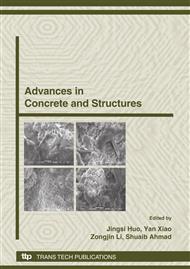p.227
p.233
p.239
p.245
p.251
p.257
p.263
p.269
p.275
Stochastic Damage Constitutive Model for Concrete Considering Strain Rate Effect
Abstract:
The present work concentrates on the model of concrete under dynamic loading. The stochastic damage constitutive model for concrete under static loading developed by the authors’ research group is firstly reviewed in this paper. The strain rate effect is considered as viscous effect so that the dynamic generalization of the static model could be developed by analogy with viscous-plastic theory. Combined with static damage expressions, the frame work of dynamic stochastic damage constitutive relationship for concrete is established. The analytical expression of dynamic increase factor (DIF) of peak stresses under tension and compression are derived according to the present dynamic damage model. Several simulation results of concrete under static as well as dynamic loading are provided to demonstrate its capacity of reproducing the salient features experimentally observed.
Info:
Periodical:
Pages:
251-256
Citation:
Online since:
October 2008
Authors:
Price:
Сopyright:
© 2009 Trans Tech Publications Ltd. All Rights Reserved
Share:
Citation:


